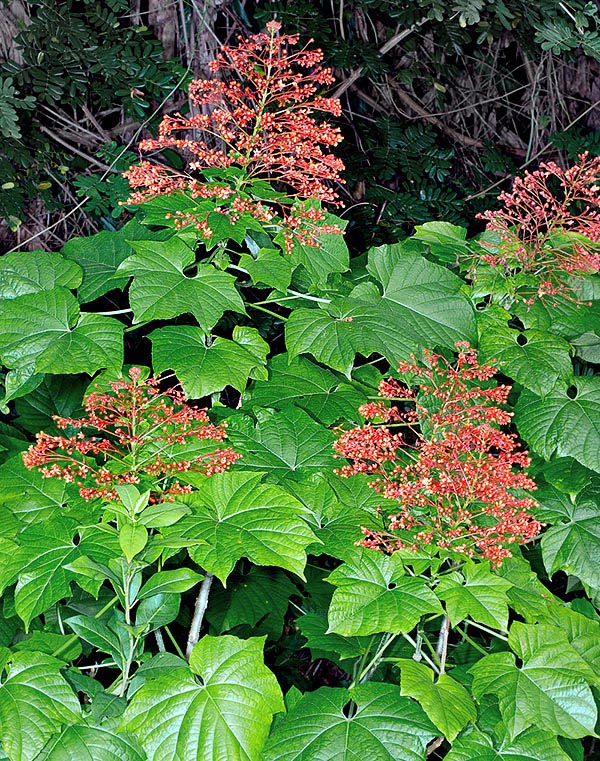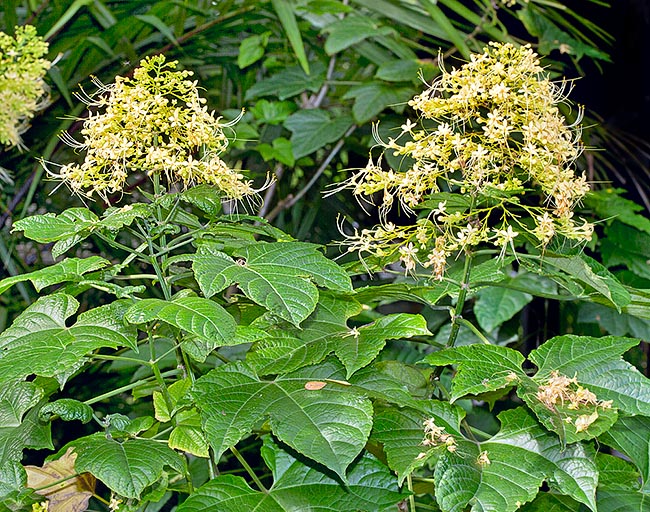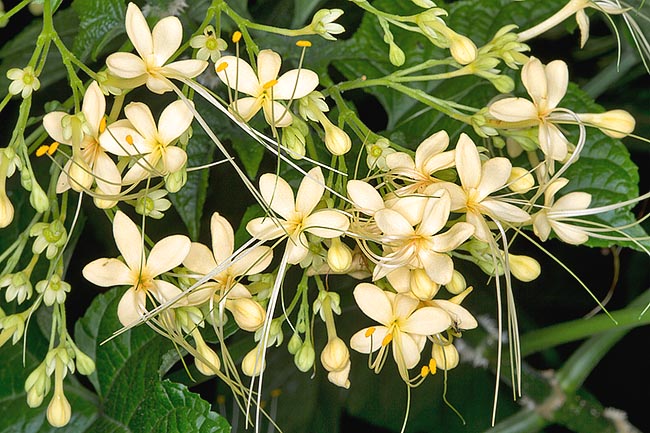Family : Lamiaceae

Text © Pietro Puccio

English translation by Mario Beltramini

Clerodendrum paniculatum is an evergreen tropical shrub, fast growing, 0,8-2,5 m tall, semi-woody perennial little ramified, has branches with almost quadrangular section © Giuseppe Mazza
The name of the genus is the combination of the Greek terms “κλῆρος” (cleros) = fate and “δένδρον” (dendron) = tree, name given by Johannes Burman (1707-1780), taken up by Linnaeus, to a plant that in Ceylonese was called “pinnacola” = ill-fated ; the specific name is the Latin adjective “paniculatus, a, um” = equipped with panicle, with reference to the inflorescence.
Common names: Java glory bower, pagoda-flower, pagoda plant, scarlet glory bower, red pagoda flower (English); bao da lung chuan hua, lung chuan hua (Chinese); arbre pagode (French); kala huo vo, kalahoya, tamguong, tangvong, yamon (Hindi); panggil-panggil, pepanggil (Malaysian); ora-ojola, adabi (Nigerian); flor do pagode (Portuguese-Brazil); Krishna Kireedam (Tamil).
The Clerodendrum paniculatum L. (1767) is a semi-woody perennial shrub little ramified, evergreen, 0,8-2,5 m tall, with branches with almost quadrangular section glabrous or pubescent and villous nodes.
The leaves, on a 4-30 cm long pubescent petiole, are opposite, 5-24 cm long and 8-30 cm broad, irregularly palmatelobed, with cordate base and 3-5 (rarely 7) lobes with entire margins or slightly toothed and pointed apices, of glossy dark green colour above and rough to the touch, dotted of tiny whitish scales below.

Native to South-East Asia, has at once entered as ornamental plant the tropical gardens for its showy inflorescences that can reach 60 cm. Leaves and roots have also medicinal virtues © Giuseppe Mazza
Campanulate calyx deeply engraved in 5 lanceolate lobes with obtuse or acute apex, about 0,5 cm long, imbutiform corolla with thin tube, 1,2-2 cm long, and 5 oblong-ovate lobes, 0,6 cm long, 4 ascending stamina of the same colour as the corolla, 4-5 cm long, quadrilocular ovary and style, about of the same length as the stamina, bilobed at the apex.
The fruits are globose 4 cells drupes with persistent lobes of the calyx, of 0,5-0,8 cm of diameter, initially green, then bluish to black when ripe, containing 4 seeds (one per cell).
It reproduces by seed, rarely produced out from the origin zones, through the root suckers coming out close to the base of the plant and by cutting in summer, utilizing portions of semi-woody stem, devoid of almost all the leaves, placed to root in a substratum formed per at least 50% by perlite, maintained constantly humid. Amply cultivated due to the showy long lasting inflorescences and the ornamental foliage in the gardens of the tropical and humid subtropical climate countries where often has naturalized becoming in some instances invasive.

A yellowish white variety does exist, at once multiplied by the horticulturists © Giuseppe Mazza
Fast growing and of easy cultivation requires an exposition preferably in full sun, even if it stands a slight shade, and is not particular about the soil, even if growing best in the fertile and well drained ones, maintained almost con- stantly humid, acidic to slightly alkaline.
Useful are periodical fertilizations with a balanced product during the vegetative season and a light pruning by the end of blooming in order to maintain a compact posture.
It can be cultivated in capacious containers, utilizing an organic loam with addition of sand or perlite per a 30%, to be sheltered during the coldest months where the climate does not allow the open air permanence, for the decoration of greenhouses, winter gardens and verandahs, in an as much as possible luminous position and with lowest night temperatures over the 14 °C. The waterings must be regular and abundant in summer, spaced in winter, but without ever allowing the substratum to dry up completely.

Imbutiform corolla with thin tube, 1,2-2 cm long, 5 oblong-ovate lobes and 4 ascending stamina of same colour © Giuseppe Mazza
The leaves and the roots are variously utilized in the traditional medicine, in particular Chinese and Indian, for various pathologies, mainly as febrifuge, antirheumatic and in the malaria care and of venereal diseases. In some countries of South-East Asia, such as Malaysia, it holds also an important role in magic rituals, attributing it the power to protect from evil and to evoke the spirits.
Synonyms: Caprifolium paniculatum Noronha (1790); Volkameria angulata Lour. (1790); Clerodendrum diversifolium Vahl (1791); Volkameria diversifolia Vahl (1791); Clerodendrum pyramidale Andrews (1811); Cleianthus coccineus Lour. ex B.A.Gomes (1868).
→ To appreciate the biodiversity within the family LAMIACEAE please click here.
